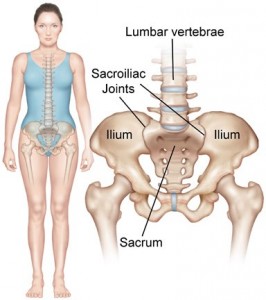 The anatomy of the low back is very complex. there are a lot of moving parts and thus many things that can go wrong causing low back pain. There are essentially 2 main reasons people have low back pain – irritation of nerves or irritation of muscle (or other soft) tissue. Irritation of nerves typically starts at the spine. In order to understand the irritation of nerves that start at the spine, we must review some anatomy. The low backbone structure consists of the pelvis and sacrum at the bottom of the foundation followed by 5 lumbar vertebrae stacked on top of each other that all sit on top of the sacrum of the pelvis. The sacrum is the foundation of the spine of which the lumbar vertebrae sit on top of it. The sacrum is then connected to the pelvis of which your hips and legs then attach below. The lumbar vertebrae all have a cartilaginous disc in between each of them that allow the spine to flex and twist. Also in between each vertebrae is a place where nerve roots exit on either side of each vertebrae. It is the irritation of these nerve roots which causes a vast majority of low-back pain. these nerve roots can become pinched by misaligned vertebrae or when discs bulge out or even herniate (the disc material leaks out under pressure) putting pressure on the nerve roots leading to low back pain. Lower back muscles are divided into 3 main groups
The anatomy of the low back is very complex. there are a lot of moving parts and thus many things that can go wrong causing low back pain. There are essentially 2 main reasons people have low back pain – irritation of nerves or irritation of muscle (or other soft) tissue. Irritation of nerves typically starts at the spine. In order to understand the irritation of nerves that start at the spine, we must review some anatomy. The low backbone structure consists of the pelvis and sacrum at the bottom of the foundation followed by 5 lumbar vertebrae stacked on top of each other that all sit on top of the sacrum of the pelvis. The sacrum is the foundation of the spine of which the lumbar vertebrae sit on top of it. The sacrum is then connected to the pelvis of which your hips and legs then attach below. The lumbar vertebrae all have a cartilaginous disc in between each of them that allow the spine to flex and twist. Also in between each vertebrae is a place where nerve roots exit on either side of each vertebrae. It is the irritation of these nerve roots which causes a vast majority of low-back pain. these nerve roots can become pinched by misaligned vertebrae or when discs bulge out or even herniate (the disc material leaks out under pressure) putting pressure on the nerve roots leading to low back pain. Lower back muscles are divided into 3 main groups
1. Extensor muscles – These muscles are located at the lower left and right sides of the spine. These are the most visible muscles of the lower back. They help you to stand and lift heavy objects.
2. Flexor muscles – These muscles are attached to the front of the front of the spine and the abdominal wall. These muscles help you to flex, bend and assist in lifting as well.
3. Iliopsoas muscles – these muscles are attached to the spine and inside the pelvis. These muscles help the spine rotate and flex and bend. They also help stabilize your posture and balance while standing as well.
Now that we have established the anatomy of low-back, we can now discuss the specifics of why low back pain occurs. There is a multitude of reasons for low back pain. But below are the most common reasons:
1. Subluxation – Subluxation is defined in chiropractic as any joint that becomes slightly misaligned or stops moving correctly. The most common types of subluxations in the low back involve:
a) Facet joints – The facet joints are the most posterior joints connecting each of the five vertebrae including joining the fifth vertebra to the sacrum. Since these joints are located on the posterior side of the vertebrae, leaning back in extension will typically increase any low back pain caused by subluxation of these joints.
b) Sacroiliac joints – The sacroiliac joints (or S.I. joints) connect the sacrum to the pelvis.
2. Disc problems – The discs located in between each of the vertebrae and in between the last vertebra and the sacrum can bulge or herniate. Located in the center of each disc is a gelatinous material. Over time the walls of the disc can weaken and break down allowing this gelatinous material to push out or bulge toward the outside of the disc. If the wall breaks and the material actually leaks out, this is called a herniated disc. The problem with a bulge or a herniated disc comes when the displaced disc places pressure posteriorly toward the nerve roots that are exiting on either side of the spine at any of the various levels of the vertebrae. This can cause not only low back pain but also pain down the leg as well. In some scenarios, this issue can cause issues with organs because there are also branches coming off those nerve roots leading to the front of the abdominal cavity. In a worse case scenario, there can be loss of bowel and bladder function. This is an emergency situation that might require a surgical intervention.
3. Muscle weakness or injury – Problems with the muscles of the low back can also be a cause of low back pain. These muscles can weaken over time or spasm due to a strain, causing low back pain.

